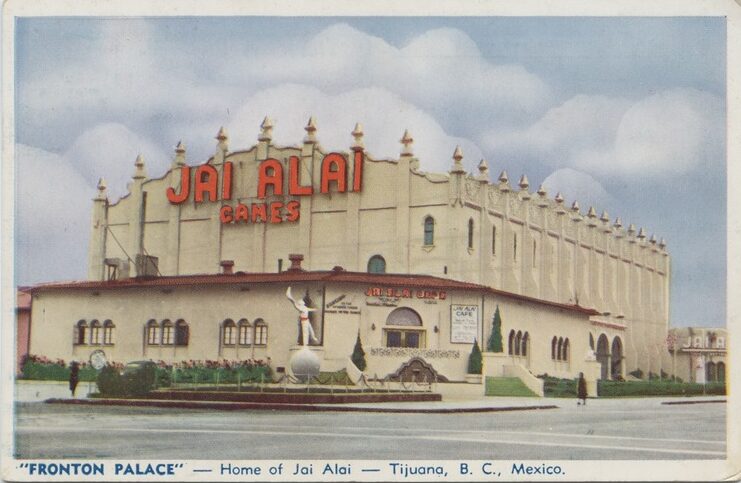
If you’ve spent any time on Tijuana’s Avenida La Revolución, you’ve probably noticed the giant Moorish-style building that resides between 7th and 8th streets with the giant red neon “JAI ALAI” sign on the front. Rich with history, this building, known locally as “El Palacio,” once housed the lively sport of Jai Alai.
About Jai Alai
Jai alai is considered one of the fastest and most dangerous sports in existence. It’s also called Basque Ball because it originated as a handball game over four centuries ago in the Basque area of Spain’s Pyrenees Mountains. It was a game played on Sundays and holidays, so when the sport was exported to Cuba in 1900, the Western Hemisphere name for the game became jai alai meaning “merry festival” in Basque. In Spain, the game is known as cesta punta.
The game is played with two opposing players or of two teams consisting of two players each, on a court. The pelota (ball) is made of hand-wound rubber covered by leather and is slightly smaller than a baseball and harder and heavier than a golf ball. It’s thrown at speeds of over 150 miles per hour. A cesta (basket) is strapped to the players arm and is used to cradle and throw the ball at a granite wall. The opposing player must catch and return the ball in one fluid motion or the other player gets a point. Most games are played with “spectacular seven” scoring where the first player/team to reach seven points wins. The game is usually played in a round-robin rotation with eight teams/players participating. The arena that houses the courts is called a frontón.
Tijuana’s Jai Alai Palace
Jai alai spread quickly in the early 1900s to Hispanic speaking countries and the Phillippines as well as parts of the U.S. such as Florida where it became a popular sport for gambling. Construction for Tijuana’s jai alai palace started in 1926, but the depression and then WWII delayed the process. The building was finally completed and inaugurated in 1947. The jai alai palace in Tijuana was the premier destination for the sport in the American Southwest and the game drew audiences from both sides of the border.
By the 1980s interest in the sport faded. Coupled with player strikes and poor attendance, El Palacio was finally forced to close in 2002. After some renovations, the building was reopened in 2005 as a concert venue known as “El Foro.” The building still retains its famous façade and red neon signage, as well as a statue in front of a jai alai player, which all pay homage to the building’s historic past.
